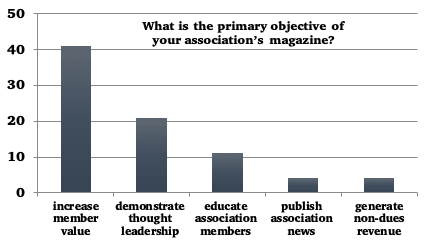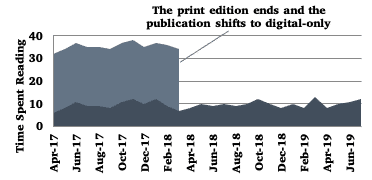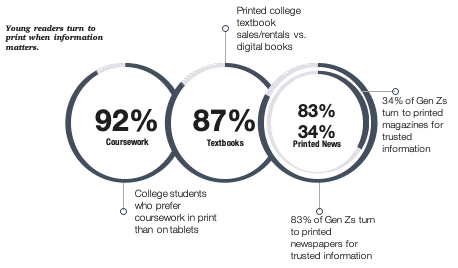5 Questions to Ask Before Pulling the Plug on Your Association Magazine

No doubt the pandemic, inflation and the push for digitization have all made associations rethink their approach to marketing communications.
This puts into question all legacy programs, including flagship publications, a once-venerated communications asset that has come under fire recently as production costs have increased and revenues have decreased. But before you cut too deep, ask yourself and your organization’s senior leadership the following five questions — questions that may produce answers that put your communications strategy into perspective.
1. The Value Question
Q: If you eliminate or scale back your print program, what will you replace it with that is at least as valuable—if not, more—than print?
At a time when increasing member value seems to elude many associations, stripping your constituents of an asset that typically ranks among your top three member benefits may not be the best strategy. In a comprehensive study of association publishers commissioned by Association Media & Publishing (AM&P), respondents were asked to rank their association print publication’s primary objective. Overwhelmingly, the most common response cited: “increase member value.” The least cited response: “generate non-dues revenue.”
Additionally, cutting print in favor of increased digital communication may have an adverse effect on member engagement. According to the 2019 Annual Associations Communication Benchmarking Report published by Naylor Association Solutions, “information overload/cutting through the clutter” was ranked the No. 1 communication challenge for associations for the seventh time in eight years.

Source: AM&P
Consider that there are 17 new web pages published every second, according to digital marketing expert, speaker and best-selling author Andrew Davis. In his webinar, “The Future of Digital is Print”, Davis states that too many organizations are rushing into digital, contributing to information overload.
“Marketers are chasing the social stream, chasing the perceived opportunity and trying to squeeze into that gap,” he says. “One of the biggest opportunities today is to be a part of the information that one can actually consume. This is all about creating quality content over quantity. There’s a tremendous opportunity to fit print into this.” Also, many organizations and businesses increased their digital communications during the pandemic, leaving plenty of open space for print as a welcome respite from the screen.
There is also a psychological appeal to print. In a recent article from the Missouri School of Journalism’s Donald W. Reynolds Journalism Institute (RJI), author Damon Kiesow explains that print offers readers a feeling of “completeness.” In other words, something that has a beginning, a middle and an end provides readers the feeling of being informed, rather than the feeling of being overwhelmed by the endless flow of information being published on the internet. There are other psychological benefits to print. In its 2020 Factbook, MPA-The Association of Magazine Media reports that paper-based reading offers singular benefits. Among them:
- More focused attention, less distraction
- Higher comprehension and recall
- Stimulates emotions and desires
- Preferred by the majority (even younger audiences)
- Drives sensory involvement, which contributes to reader impact
- Slower reading speeds
2. The Market Position Question
Q: How will your organization maintain its market presence?
An organization’s value is inextricably tied to the quality of its products. For associations, that product is information and education, as well as access to peer networks and best practices. Remove the print magazine and you eliminate a big piece of the information pie you provide members, as well as the marketplace at large. Without it you are less relevant. Without it you leave a gap to be filled by a competitor, nonprofit or otherwise.
Read More: 4 Tips for Redesigning Your Magazine
In fact, there’s a growing trend around for-profit publishers launching membership programs. These for-profit publishers are leveraging the association business model to gain market share—and it’s working. In a recent article for WNIP, author Mary Hogarth writes, “As magazine subscriptions decline, widening audience participation and creating communities has now become a top priority [for publishers]. One emerging trend is the creation of memberships schemes, which are fast becoming an attractive alternative to subscriptions.
These membership schemes enable publishers to not only build a community, but package their content across print, digital and online.“ Sound familiar? Building community was once the cornerstone of the association value proposition. Now, publishers are vying for a piece of the action, and they would be happy to fill the vacancy left by your publication.
Read More: 10 Ways Members Can Support Your Content Creation
And once that ground has been lost, it is difficult to regain. When you lose mindshare, you eventually lose share of wallet as well. The print magazine is a tangible representation of membership to an exclusive community of industry leaders, a showpiece that validates your members’ commitment to that community and to their own professional development.
3. The Member Engagement Question
Q: How will your organization engage its members?
Content experts know that page visits and impressions are vanity metrics, but engagement metrics— such as session length and time on page—truly reveal content’s effectiveness. Research on reader behavior shows that people spend less time reading digital content than print content. Further, more time spent with a brand renders higher perceived value, which renders loyalty, which renders conversions and recommendations.

Source: https://www.tandfonline.com/doi/full/10.1080/17512786.2019.1685903
Take, for example, two British publications, The Independent and New Musical Express, which ceased print production in 2016 and 2018, respectively. Both saw time spent with their brands fall sharply after going digital-only. Neither publication was able to translate the loyalty of its print readership to its online content. Print engagement is an asset not easily transferable to the digital realm.
4. The Revenue Question
Q: How will your organization replace lost revenue?
Not only is engagement elusive with a digital-only publication, so is revenue. Before the pandemic, association print programs were under scrutiny for not bringing in enough revenue, a task they are not intended nor designed to do. Enabled by member dues rather than advertising revenue, association print programs deliver on a promise to provide members a carefully curated and vetted assortment of content: market trends, best practices, thought leadership, and the member profiles.
For publications with declining ad revenue, it’s rarely because of declining reader value. Declining print ad revenue is often due to advertisers splitting budgets between digital and print. So any publisher that doesn’t have a strong digital content offering to complement its print publications is missing out, as seven in 10 Americans prefer a mix of digital and print content to engage with. In many cases, print advertising is the gateway to other assets such as e-newsletter or website advertising.

Source: AM&P
5. The Credibility Question
Q: How will your organization maintain credibility?
Other casualties of eliminating print from your overall marketing and communications strategy are trust and authenticity. With such a low barrier to entry, anyone can publish on the internet.

Source: http://printinthemix.com/Research/Show/125
While this accessibility can have a positive impact on the diversity of voices and perspectives, it also fosters the spread of bad information, sometimes with the intent to mislead. Disinformation and fake news have become prolific and have changed many readers’ attitudes about online reading. Even reputable publishers struggle to overcome this uncertainty, and for good reason.
As digital publishers look for ways to monetize their websites, they must sell space to advertisers and sponsors whose content is often styled to blend in with the publisher’s, making it difficult for readers to distinguish between news, opinion, advertising, and plain dishonesty.

Source: Words Onscreen by Naomi Baron
Bonus: What About Millennials?
- 76% believe fake news is the biggest societal problem now.
- 69% trust print magazines.
- 54% trust digital-only publications.
- 34% trust social media.
Final Thoughts
As you evaluate your organization’s communications channels, don’t think print is passé—instead, consider it to be one of the hardest working assets in your marketing communications toolbox. It differentiates your organization in ways no other channel can: It’s tangible, inherently authoritative and trustworthy, memorable; and it’s a showpiece that demonstrates you belong to an exclusive club of the top professionals/leaders in your industry.
No digital product can replicate it.

